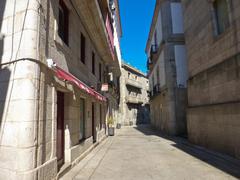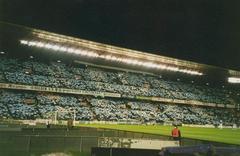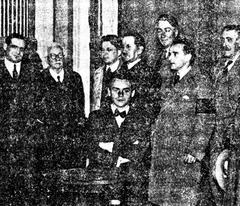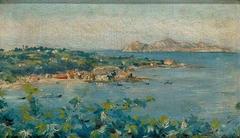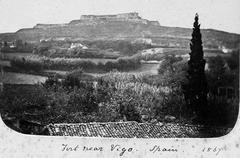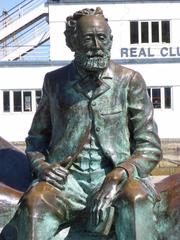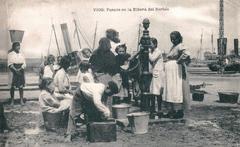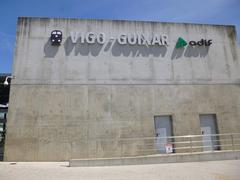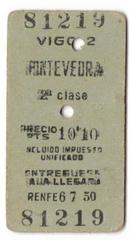
Old Town of Vigo: Visiting Hours, Tickets, and Historical Sites Guide
Date: 14/06/2025
Introduction
Vigo’s Old Town, known locally as Casco Vello, is a vibrant tapestry of Galician history, maritime tradition, and modern culture. Nestled on the Atlantic coast, this district blends ancient origins, medieval fortifications, lively plazas, bustling markets, and renowned gastronomy. Whether you’re a history buff, a foodie, or a curious traveler, Vigo Old Town offers an immersive experience into the heart of Galicia. This guide details the area’s historical evolution, top sites, visiting hours, ticket information, accessibility, and practical tips to help you make the most of your visit (Barceló Guide, Turismo de Vigo, Official Vigo Tourism Portal).
Historical Overview
Prehistoric to Roman Times
The roots of Vigo Old Town reach back to prehistoric settlements, as evidenced by Stone Age tools and artifacts displayed at the Castrelos Municipal Museum. During the Roman era, Vigo (from the Latin “Vicus,” meaning village) became part of the province of Gallaecia. Roman ceramics, coins, and building remains found throughout the city indicate a period of prosperity, with trade and infrastructure laying the foundations for future growth (Explorial, Vigo.com).
Medieval Development and Fortifications
After the fall of Rome, Vigo saw successive waves of Celtic and Germanic settlements. Between the 9th and 12th centuries, it endured Viking and Norman raids, prompting the construction of stone fortifications, bridges, and churches. Today, only a handful of these medieval structures survive, bearing witness to the city’s resilience through centuries of conflict (Vigo.com, Barceló Guide).
Early Modern Era and Maritime Expansion
By the 16th and 17th centuries, Vigo’s growth was spurred by the sardine fishing industry and maritime trade. Pirate attacks, including those led by Sir Francis Drake, resulted in the construction of city walls and defensive bastions. The Battle of Rande in 1702, part of the War of Spanish Succession, saw a Franco-Spanish fleet defeated in Vigo’s estuary, cementing the city’s strategic importance (Vigo.com, Explorial).
The lifting of trading restrictions with the Americas in 1778 further fueled Vigo’s prosperity, turning it into a bustling Atlantic port.
Industrialization and the Reconquista
In the 19th century, Vigo underwent rapid industrialization, with new shipyards, canning factories, and a railway line transforming its economy. During the Peninsular War, locals expelled Napoleon’s forces in 1809, earning Vigo the title “Faithful, Loyal, and Valiant.” This victory is celebrated annually in the Old Town’s Reconquista Festival (Barceló Guide, HollyMelody).
20th Century to Present
Despite suffering damage during the Spanish Civil War, Vigo’s Old Town has experienced significant renewal. Restoration projects and urban revitalization have preserved its historic character while fostering a lively arts, culinary, and festival scene (Turispanish). Today, Casco Vello stands as both a living museum and a modern social hub.
Visiting Vigo Old Town: Practical Information
Visiting Hours
- District Access: Vigo Old Town is an open public area, accessible 24/7.
- Key Sites:
- Santa María Collegiate Church: 9:30 am–1:00 pm, 6:00 pm–8:30 pm (daily)
- Castro Fortress: 10:00 am–7:00 pm (Apr–Oct); 10:00 am–5:00 pm (Nov–Mar)
- Museo do Mar de Galicia: Tue–Sun, 10:00 am–7:00 pm; closed Mondays.
Check official sites for seasonal updates.
Tickets and Entry Fees
- General Entry: Streets, plazas, and most outdoor areas are free to explore.
- Monuments & Museums:
- Santa María Collegiate Church: Free
- Castro Fortress: Free; guided tours €5
- Museo do Mar de Galicia: €3 (discounts available)
Tickets for museums can be purchased online or on-site. Guided walking tours are available through local agencies.
How to Get There
- By Foot: Central location, easily walkable from bus/train stations.
- Public Transport: Local buses and taxis available.
- Parking: Limited paid garages nearby; recommended to use public transport during busy periods.
Accessibility
- Mobility: Cobblestone streets and slopes may challenge those with limited mobility, but main plazas and museums offer accessible routes.
- Assistance: Contact tourist offices for detailed accessibility information.
Highlights and Must-See Historical Sites
Porta do Sol
Vigo Old Town’s gateway, this lively square connects the historic core with the modern city. It’s a hub for street performances, markets, and public art.
Mercado das Ostras
A legendary open-air oyster market, active late mornings to early afternoons (11:00 am–3:00 pm). Sample freshly shucked oysters paired with Albariño wine (Official Vigo Tourism Portal).
Santa María Collegiate Church
A 19th-century neoclassical landmark with striking stained glass. Free entry, open daily as above. Central to local religious and civic traditions.
Castro Fortress (Castelo do Castro)
Offering panoramic views of Vigo and the estuary, this 17th-century fortress is a short walk from the Old Town. Guided tours available; some areas may be difficult for those with mobility issues (Castro Fortress Information).
Praza da Constitución
The social and administrative heart of Casco Vello, surrounded by arcaded buildings and lively terraces. Hosts markets and the annual Reconquista Festival.
Rúa Real and Rúa dos Cesteiros
Cobbled lanes featuring artisan basket-makers, independent boutiques, and tapas bars. An authentic window into Vigo’s traditional trades and daily life.
Museo do Mar de Galicia
A modern maritime museum on the waterfront, showcasing Vigo’s fishing heritage, ancient shipwrecks, and interactive exhibits. Admission: €3 (Museo do Mar de Galicia).
Gastronomy and Culinary Traditions
Vigo’s Old Town is famed for its seafood, tapas, and Galician specialties:
- Seafood: Mussels, oysters, scallops, octopus (pulpo á feira), clams, and local fish.
- Regional Dishes: Empanada Gallega (savory pie), Caldo Gallego (hearty soup), Arroz con Mariscos (seafood rice), Tarta de Santiago (almond cake).
- Tapas Culture: Bars and taverns around Praza da Constitución and Mercado da Pedra serve small plates paired with local wines (especially Albariño).
Recommended Venues:
- Restaurante O Chan da Barca: Traditional Galician fare.
- Maruja Limón: Michelin-starred, creative cuisine.
- Mercado da Pedra: Popular for fresh oysters and shellfish.
Dining hours are typically 1:30 pm–3:30 pm (lunch) and 8:30 pm–11:00 pm (dinner). Reservations are recommended for popular spots.
Festivals and Events
- Reconquista Festival (late March): Historical reenactments, markets, and street food celebrating the city’s victory over Napoleonic troops.
- Feast of Saint James (July): Traditional music, parades, and local crafts.
- Christmas Markets (December): Festive atmosphere with Galician food and artisan gifts.
Practical Tips for Visitors
- Best Visiting Times: Early mornings or late afternoons for fewer crowds and best photography light.
- Getting Around: Wear comfortable shoes; the area is hilly and cobbled.
- Language: Spanish and Galician are spoken; English menus are common in tourist areas, but basic Spanish or Galician phrases are appreciated.
- Safety: Vigo is generally safe, but mind your footing on uneven streets.
- Accessibility: Some areas may be challenging for wheelchairs or strollers.
Scenic Excursions
- Ferry to Cangas: Regular departures from Estación Marítima offer beautiful harbor views.
- Coastal Walks: Trails from Samil Beach showcase dramatic Atlantic vistas.
- Nearby Attractions: The Cíes Islands, a national park, are accessible by ferry and ideal for nature lovers.
Frequently Asked Questions (FAQ)
Q: Do I need tickets for Vigo Old Town?
A: No tickets are required for public areas; some museums/landmarks have small entrance fees.
Q: What are the typical opening hours for main sites?
A: Most sites open around 9:00 or 10:00 am and close by 6:00–8:00 pm. Check specific sites for seasonal changes.
Q: Is the Old Town accessible for visitors with disabilities?
A: Main plazas and museums provide accessible routes, but some cobbled lanes and steep streets may pose challenges.
Q: Are guided tours available?
A: Yes, several operators offer tours focused on history, gastronomy, or art.
Q: Where can I find the best seafood?
A: Mercado das Ostras, Mercado da Pedra, and local taverns around Praza da Constitución.
Visual and Interactive Resources
Enhance your trip by browsing virtual tours and images on official tourism portals:
- Panoramic shots of Praza da Constitución
- Close-ups of granite façades and historic street scenes
- Festival and market photography
- Street art and mural galleries
These visuals provide a preview of Vigo’s unique architectural and cultural landscape.
Sources and Further Reading
- Barceló Guide
- Turismo de Vigo
- Official Vigo Tourism Portal
- Museo do Mar de Galicia
- Explorial
- Turispanish
Plan Your Visit
Vigo Old Town is a living chronicle of Galicia—rich in history, culinary delights, and vibrant community spirit. Whether you’re savoring oysters at the Mercado das Ostras, climbing the ramparts of Castro Fortress, or joining in local festivals, Casco Vello promises an authentic and memorable Galician experience. For real-time updates, interactive maps, and guided tours, download the Audiala app and follow us on social media. Start planning your adventure now and experience the enduring charm of Vigo Old Town!
